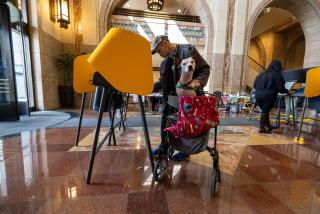Villaraigosa’s 30/10 vision
- Share via
Mayor Antonio Villaraigosa has been in Washington this week, meeting with other cities’ chief executives and, more important, asking key lawmakers and transportation officials to support an audacious public works plan that simultaneously addresses Los Angeles’ unemployment and traffic crises.
Villaraigosa never has been short on ambitious ideas, but his so-called 30/10 proposal is one of the best he’s ever put forward. It deserves the support not only of the Obama administration but also of both sides of the aisle in California’s large but fractious congressional delegation.
Essentially, the mayor is taking the administration at its word when it says it wants to focus on jobs and to stimulate the economy by steering funds to “shovel-ready” projects. The 30/10 plan does both of those things, and does so in a shrewd and attractive way.
The mayor’s proposal starts with last year’s passage of Measure R, in which Los Angeles County voters agreed to increase the sales tax by half a cent for 30 years in order to raise $40 billion to construct a specific roster of mass transit projects, including westward extension of the subway to Santa Monica and additions to the light-rail Gold Line in the San Gabriel Valley.
In essence, Villaraigosa wants Washington to give the Metropolitan Transportation Authority what amounts to a bridge loan so that rather than stretching the construction projects out over three decades, as Measure R anticipated, all the work can be completed in just 10 years. The loan would be secured by the tax revenue county voters already have pledged to the projects.
As such, it presents the administration with an opportunity to create badly needed jobs and invest in a region that desperately needs traffic relief -- at no long-term cost to the federal budget.
As Villaraigosa pointed out in Washington this week, “At a time when almost all states and most cities are going to Washington with one hand open, we’re going with money in one hand and an open hand for a partnership in the other.” In early meetings with lawmakers, he urged them to give special consideration to the fact that “we’re the one city in the country that -- in the middle of a recession -- passed this measure. . . . We could be a blueprint of what other cities should be doing.”
That would be a pleasant change indeed.
By some estimates, speeding up the construction schedule for all of the county’s pending transit projects -- which includes filling in gaps in the existing light-rail system as well as new lines along Crenshaw Boulevard and westward along the Exposition right of way -- would create as many as 116,000 construction jobs. That’s no small thing because nearly 40% of the county’s construction workers are jobless. Moreover, because the deep and lingering recession has pushed down the costs of labor and materials, MTA officials believe letting as many contracts as possible now will save taxpayers money in the long run.
On a recent visit to Los Angeles, Rep. Peter DeFazio (D-Ore.), an influential member of the House Transportation and Infrastructure Committee, agreed that “these sorts of things are what we really need to do. . . . Taking one of the most congested places in the country and taking a big-bang approach is visionary. The problem is that this hasn’t been done before. The federal government hasn’t worked with a region on a scale like this.”
Transportation Secretary Ray LaHood reportedly is similarly impressed by the 30/10 proposal but cautions that the federal government never has provided this sort of bridge-loan financing.
This proposal’s novelty shouldn’t be allowed to become an obstacle. We’re still passing through the worst financial and unemployment crisis since the Depression.
Villaraigosa’s plan relies on taxes that voters already have approved, and it is one of the few on the table whose scope and practicality matches that of the New Deal’s grand public works projects.
Those programs not only ameliorated suffering bordering on despair, but also created physical assets from which we all still benefit. In that sense, they were quintessential examples of what historian Arthur Schlesinger regarded as President Franklin D. Roosevelt’s great contribution to the American system: a politics of remedy.
More to Read
Get the L.A. Times Politics newsletter
Deeply reported insights into legislation, politics and policy from Sacramento, Washington and beyond. In your inbox three times per week.
You may occasionally receive promotional content from the Los Angeles Times.










